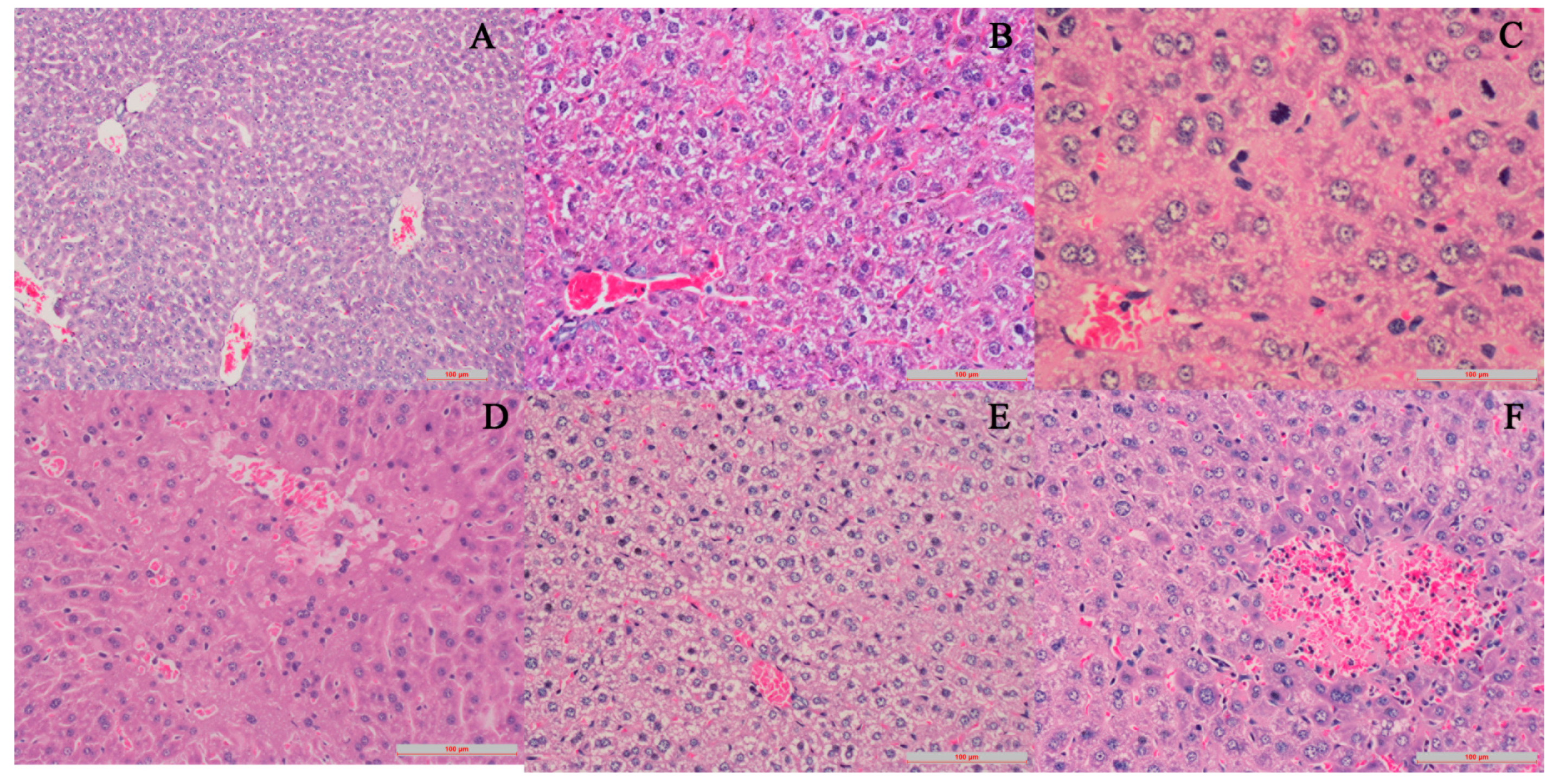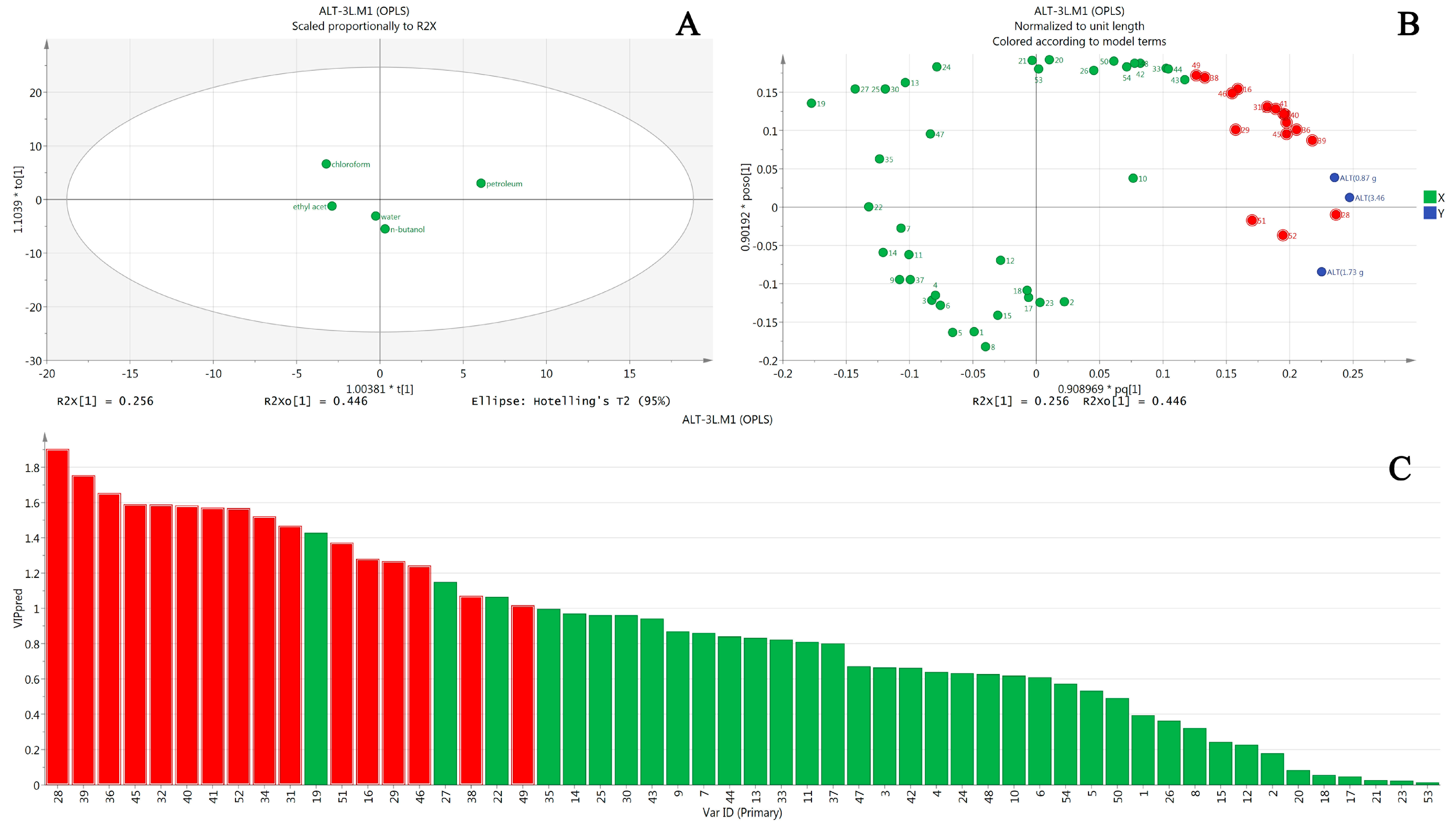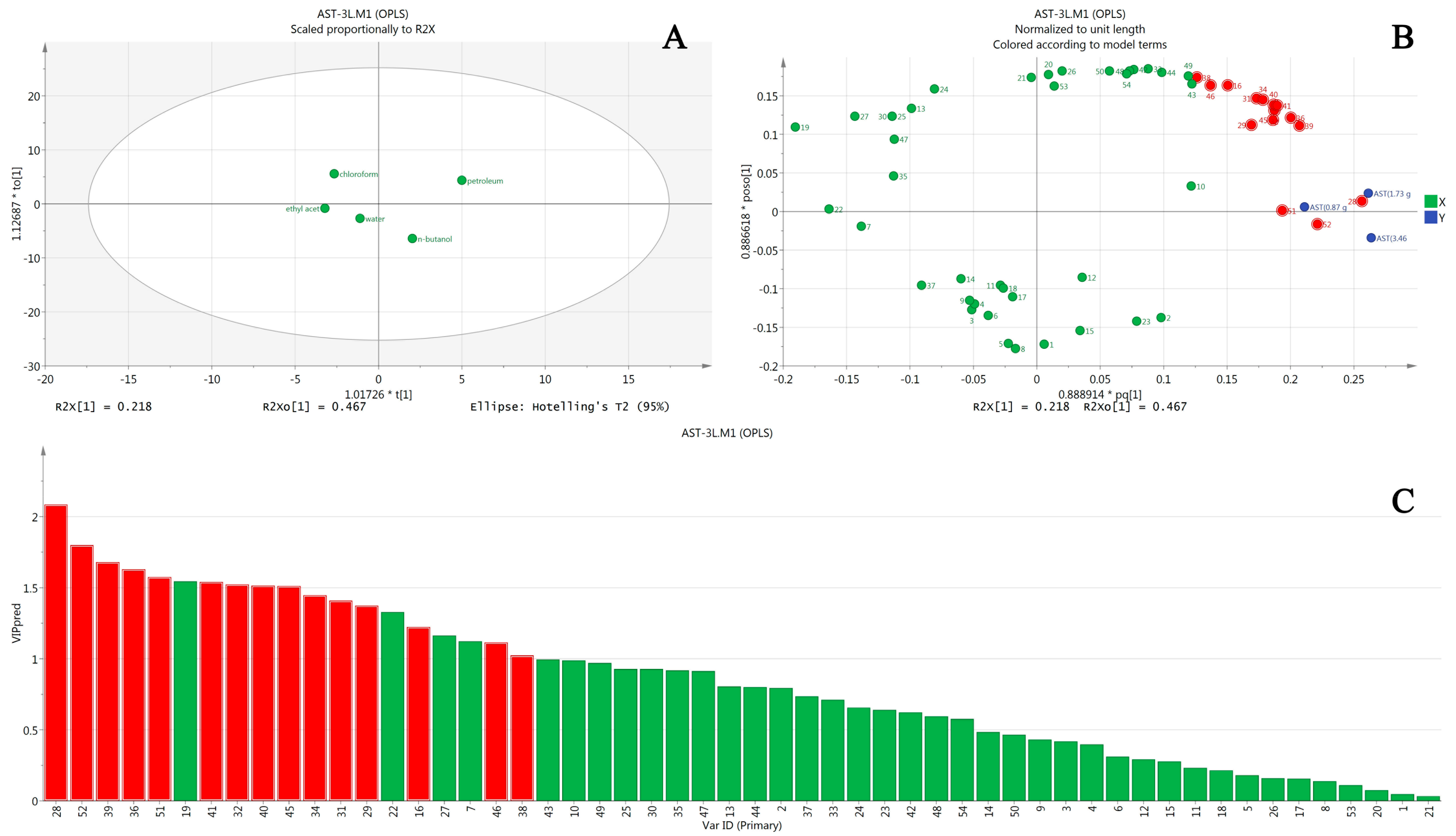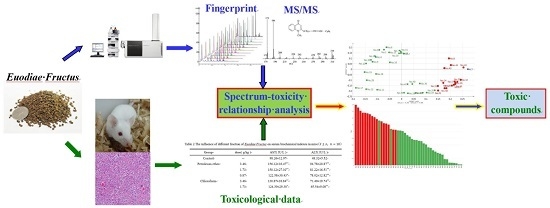Screening Hepatotoxic Components in Euodia rutaecarpa by UHPLC-QTOF/MS Based on the Spectrum-Toxicity Relationship
Abstract
:1. Introduction
2. Results and Discussion
2.1. Assignment of Major Components
2.2. Hepatotoxicity Induced by Euodia rutaecarpa
2.2.1. Observation of General Condition
2.2.2. Examination of the Liver-Weight-to-Body-Weight Ratio
2.2.3. Effect on Pathology of Mice Livers
2.2.4. Effect on Serum Biochemical Indices of Mice
2.3. Spectrum-Toxicity Relationship Analysis
2.3.1. OPLS Results of ALT
2.3.2. OPLS Results of AST
3. Materials and Methods
3.1. Samples, Reagents and Animals
3.2. Apparatus and Conditions
3.3. Preparation of Samples and Sample Solution
3.4. Animal Experiments
3.5. Data Handling
4. Conclusions
Acknowledgments
Author Contributions
Conflicts of Interest
References
- Teschke, R.; Zhang, L.; Long, H.; Schwarzenboeck, A.; Schmidt-Taenzer, W.; Genthner, A.; Wolff, A.; Frenzel, C.; Schulze, J.; Eickhoff, A. Traditional Chinese medicine and herbal hepatotoxicity: A tabular compilation of reported cases. Ann. Hepatol. 2015, 14, 7–19. [Google Scholar] [CrossRef]
- Rolf, T.; Dominique, L.; Dieter, M.; Gaby, D. Traditional Chinese medicine (TCM) and herbal hepatotoxicity: RUCAM and the role of novel diagnostic biomarkers such as microRNAs. Medicines 2016, 3, 18. [Google Scholar]
- Committee for the Pharmacopoeia of People’s Republic of China. Pharmacopoeia of People’s Republic of China, 2015 ed.; Part 1; Chemical Industry Publishing House: Beijing, China, 2015; p. 171. [Google Scholar]
- Yu, H.; Jin, H.W.; Gong, W.Z.; Wang, Z.L.; Liang, H.P. Pharmacological actions of multi-target-directed evodiamine. Molecules 2013, 18, 1826–1843. [Google Scholar] [CrossRef] [PubMed]
- Wang, Y.X.; Gong, M.X.; Wang, Z.M.; Zhang, Q.W.; Gao, H.M.; Song, Y.F. A review of studies on chemical constituents of Evodia rutaecarpa. Chin. Pharm. J. 2014, 45, 641–646. [Google Scholar]
- Cai, Q.Y.; Wei, J.J.; Zhao, W.; Shi, S.; Zhang, Y.; Wei, R.R.; Zhang, Y.; Li, W.R.; Wang, Q. Toxicity of Evodiae fructus on rat liver mitochondria: The role of oxidative stress and mitochindrial permeability transition. Molecules 2014, 19, 21168–21182. [Google Scholar] [CrossRef] [PubMed]
- Kim, D.; Lee, Y.H.; Park, S.H.; Lee, M.J.; Kim, M.J.; Jang, H.S.; Lee, J.M.; Lee, H.Y.; Han, B.S.; Son, W.C.; et al. Subchronic oral toxicity of evodia fruit powder in rats. J. Ethnopharmacol. 2014, 151, 1072–1078. [Google Scholar] [CrossRef] [PubMed]
- Yang, X.W. Toxic logical assessment on safety of water and 70% ethanolic extracts of nearly ripe fruit of Evodia rutaecarpa. China J. Chin. Mater. Med. 2008, 33, 1317–1321. [Google Scholar]
- Huang, W.; Sun, R. Study on analgesic and accompanying toxic and side effects of Euodiae fructus based on clinical eficacy dose. China J. Chin. Mater. Med. 2013, 38, 2176–2181. [Google Scholar]
- Huang, W.; Zhao, Y.; Sun, R. Experimental comparison study on mice’s acute toxicity of different composition in Evodia fructus. Chin. J. Pharmacovigil. 2008, 7, 129–134. [Google Scholar]
- Sun, R.; Huang, W.; Lv, L.L. “Dose-time-toxicity” relationship study on hepatotoxicity caused by single dose volatile oil of Evodia fructus to mice. Pharmacol. Clin. Chin. Mater. Med. 2012, 28, 55–58. [Google Scholar]
- Liao, W.Q.; Li, B.; Li, L.; Zhao, J.N. Study on molecular mechanism of Euodia fructus on liver toxicity in mice. China J. Chin. Mater. Med. 2014, 39, 4865–4868. [Google Scholar]
- Li, B.; Li, L.; Zhao, J.N.; Yi, J.H. Effects of ethanol extract from Evodia rutaecarpa on acute toxicity and hepatotoxicity in rats. Pharmacol. Clin Chin. Mater. Med. 2013, 29, 120–124. [Google Scholar]
- Ying, L.; Yang, R.F.; Xia, Q.Y.; Liu, Y.P.; Zhang, S.Y.; Li, H.X. Toxicity of repeated doses of alcohol extract of evodia in target organs. Mod. Pre-Med. 2015, 42, 2600–2603. [Google Scholar]
- Zhao, X.M.; Pu, S.B.; Zhao, Q.G.; Gong, M.; Wang, J.B.; Ma, Z.J.; Xiao, X.H.; Zhao, K.J. Preliminary study on effective components of Tripterygium wilfordii for liver toxicity based on spectrum-effect correlation analysis. China J. Chin. Mater. Med. 2016, 41, 2915–2921. [Google Scholar]
- Qin, K.M.; Zheng, L.J.; Shen, B.J.; Zhang, X.H.; Li, H.; Di, L.Q.; Xu, Z.S.; Cai, B.C. Application of spectrum-effect relationship in Chinese medicine research and related thinking. China J. Chin. Mater. Med. 2013, 38, 26–31. [Google Scholar]
- Liu, X.; Wang, X.L.; Wu, L.; Li, H.; Qin, K.M.; Pei, K.; Liu, T.; Cai, B.C. Investigation on the spectrum-effect relationships of Da-Huang-Fu-Zi-Tang in rats by UHPLC-ESI-Q-TOF-MS method. J. Ethnopharmcol. 2014, 154, 606–612. [Google Scholar] [CrossRef] [PubMed]
- Zheng, Q.F.; Zhao, Y.L.; Wang, J.B.; Liu, T.T.; Zhang, B.; Gong, M.; Li, J.Y.; Liu, H.H.; Han, B.; Zhang, Y.M.; et al. Spectrum-effect relationships between UPLC fingerprints and bioactivities of crude secondary roots of aconitum Carmichaelii debeaux (Fuzi) and its three processed products on mitochondrial growth coupled with canonical correlation analysis. J. Ethnopharmcol. 2014, 153, 615–623. [Google Scholar] [CrossRef] [PubMed]
- Zhang, D.K.; Li, R.S.; Han, X.; Li, C.Y.; Zhao, Z.H.; Zhang, H.Z.; Yang, M.; Wang, J.B.; Xiao, X.H. Toxic constituents index: A toxicity-calibrated quantitative evaluation approach for the precise toxicity prediction of the hypertoxic phytomedicine-aconite. Front. Pharmacol. 2016, 7, 1–13. [Google Scholar] [CrossRef] [PubMed]
- Wang, Y.H.; Li, Y.; Zhang, Y.; Feng, G.; Yang, Z.X.; Guang, Q.X.; Wang, R.; Han, F.J. Multi-dimensional spectrum-effect relationship of the impact of Chinese herbal formula Lichong Shengsui Yin on ovarian cancer. Molecules 2017, 22, 979. [Google Scholar] [CrossRef] [PubMed]
- Liu, Z.J.; Shi, Z.L.; Tu, C.; Zhang, H.Z.; Cao, D.; Li, C.Y.; He, Q.; Li, R.S.; Guo, Y.M.; Niu, M.; et al. An activity-calibrated chemical standardization approach for quality evaluation of Salvia miltiorrhiza Bge. RSC Adv. 2017, 7, 5331–5339. [Google Scholar] [CrossRef]
- Yuan, J.B.; Chen, Y.; Liang, J.; Wang, C.Z.; Liu, X.F.; Yan, Z.H.; Tang, Y.; Li, J.K.; Yuan, C.S. Component analysis and target cell-based neuroactivity screening of panax ginseng by ultra-performance liquid chromatography coupled with quadrupole-time-of-flight mass spectrometry. J. Chromatogr. B 2016, 1038, 1–11. [Google Scholar] [CrossRef] [PubMed]
- Li, W.L.; Sun, X.M.; Liu, B.M.; Zhang, L.H.; Fan, Z.Q.; Ji, Y.B. Screening and identification of hepatotoxic component in Evodia rutaecarpa based on spectrum–effect relationship and UPLC-Q-TOFMS. Biomed. Chromatogr. 2016, 30, 1975–1983. [Google Scholar] [CrossRef] [PubMed]
- Ling, Y.; Hu, P.; Zhang, L.F.; Jin, H.G.; Chen, J.; Tao, Z.; Huang, L.; Ren, R.Y. Identification and structural characterization of acyl gluconic acids, flavonol glycosides, limonoids and alkaloids from the fruits of Evodia rutaecarpa by high performance liquid chromatography coupled to electrospray ionization and quadrupole time-of-flight mass spectrometry. J. Chromatogr. Sci. 2016, 54, 1593–1604. [Google Scholar]
- Xia, M.W.; Pan, Z.H.; Cheng, L.; Ning, D.S.; Li, Z.Q.; Luo, L. Chemical constituents of fruits from Evodia delavayi. Chin. Pharm. J. 2016, 51, 694–697. [Google Scholar]
- Yi, Y.Y.; Liu, S.S.; Han, L.W.; He, Q.X.; Zhang, Q.W.; Liu, K.C.; Yan, L.H.; Wang, Z.M. Chemical components of alkaloids from euodiafructus and their anti-angiogenic activities. Chin. J. Exp. Tradit. Med. Formulae 2016, 22, 45–53. [Google Scholar]
- Cai, Q.Y.; Wei, J.J.; Li, W.R. Comparison of analgesic effect and active ingredient content of Evodia fructus extracts. Tradit. Chin. Drug Res. Clin. Pharmacol. 2014, 25, 179–182. [Google Scholar]
- Gong, M.X.; Wang, Z.M.; Zhang, Q.W.; Li, J.R.; Song, Y.F.; Zhao, H.; Chen, Y.H. Pharmacological research progress on the effective constituents of Evodia fructus. Tradit. Chin. Drug Res. Clin. Pharmacol. 2009, 20, 183–187. [Google Scholar]
- Zhu, L.L.; Huang, W.; Huang, Y.Y.; Sun, R. Research thinking on toxicity of Evodia rutaecarpa based on efficacy and material basis. Tradit. Chin. Drug Res. Clin. Pharmacol. 2011, 8, 366–369. [Google Scholar]
Sample Availability: Samples of all the fractions are available from the authors. |




| Peak No. | Name | RT (min) | Formula | Ion Mode | Mass (m/z) | Error (ppm) | Fragment Ions (m/z) | Ref. |
|---|---|---|---|---|---|---|---|---|
| 1 | Chlorogenic acid | 3.27 | C16H18O9 | [M + H]+ | 355.0483 | −2.16 | 163.0239;145.0175 | [23] |
| 4 | Hyperoside | 4.57 | C21H20O12 | [M + H]+ | 465.0220 | −3.32 | 303.0072;285.0015 | [23,24] |
| 8 | Dehydroevodiamine | 6.18 | C19H15N3O | [M + H]+ | 302.1393 | −1.15 | 286.0555;272.0442 | [25] |
| 10 | Evodianinine | 7.05 | C19H13N3O | [M + H]+ | 300.0709 | −2.28 | 285.0506;257.0617 | [24] |
| 12 | Unknown | 7.68 | C20H13NO4 | [M + H]+ | 332.0890 | −2.10 | 285.0542;257.0657 | [5] |
| 14 | Ribalinine | 9.34 | C15H17NO3 | [M + H]+ | 260.0643 | −1.41 | 245.0362;227.0352 | [5] |
| 16 | Coniferin | 12.34 | C16H22O8 | [M + H]+ | 343.0650 | −4.12 | 313.0258;285.0372 | [23] |
| 17 | Rutaevine | 12.23 | C26H30O9 | [M + H]+ | 487.1184 | −0.57 | 469.1146;443.1410; 425.1333;337.1127 | [23,24] |
| 18 | Skimmiamine | 9.37 | C14H13NO4 | [M + H]+ | 260.0978 | −1.74 | 204.0474;186.0391 | [26] |
| 19 | limonin | 13.14 | C26H30O8 | [M + H]+ | 471.1263 | −2.03 | 453.1123;425.1252; 339.1445;161.0445 | [24] |
| 21 | Evodiamine | 15.11 | C19H17N3O | [M + H]+ | 304.1078 | 0.21 | 171.0781;161.0594; 144.0722;134.0538 | [22] |
| 22 | 6-Acetoxy-5-epilimonin | 15.32 | C28H32O10 | [M + H]+ | 529.1179 | −3.14 | 451.0981;425.1250; 367.0959;161.0451 | [23] |
| 23 | Trans-caffeoylgluconic acid | 15.44 | C16H20O10 | [M + H]+ | 373.1248 | −2.23 | 358.0505;343.0296; 325.0240 | [24] |
| 24 | Rutaecarpine | 15.78 | C18H13N30 | [M + H]+ | 288.1239 | 0.76 | 286.0616;271.0537; 244.0585;169.0614 | [23,24] |
| 25 | 1-Methyl-2-nonyl-4(1H)-quinolone | 18.41 | C19H27NO | [M + H]+ | 296.1802 | −1.18 | 186.0725;173.0667; 158.0471 | [24] |
| 26 | 1-Methyl-2-[(E)-1-undecenyl]-4(1H)-quinolone | 19.93 | C21H29NO | [M + H]+ | 312.1889 | −3.54 | 228.1118;200.0850; 186.0707;173.0652 | [24] |
| 27 | 1-Methyl-2-[(4Z,7Z)-4,7-tridecadienyl]-4(1H)-quinolone | 21.99 | C23H31NO | [M + H]+ | 338.2003 | −1.60 | 186.0744;173.0670; 159.0529 | [24] |
| 28 | 1-Methyl-2-undecyl-4(1H)-quinolone | 22.80 | C21H31NO | [M + H]+ | 314.1985 | 0.63 | 186.0701;173.0643; 144.0681;132.0482 | [24] |
| 29 | 1-Methyl-2-[(6Z,9Z,12E)-pentadeca triene]-4(1H)-quinolone | 23.36 | C25H33NO | [M + H]+ | 364.2089 | −1.51 | 334.1692;308.1591; 268.1355;200.0855; 186.0712;173.0660 | [24] |
| 31 | Evocarpine | 24.50 | C23H33NO | [M + H]+ | 340.2138 | −2.75 | 242.1244;228.1113; 200.0846;186.0703 | [24] |
| 32 | 1-Methyl-2-[(Z)-7-tridecenyl]-4(1H)-quinolone | 25.29 | C23H33NO | [M + H]+ | 340.2136 | −3.27 | 186.0713;173.0665; 159.0531 | [24] |
| 33 | 1-Methyl-2-[(6Z,9Z)-pentadecadienyl]-4(1H)-quinolone | 26.89 | C25H35NO | [M + H]+ | 366.2243 | −3.91 | 228.1114;200.0851; 186.0706;173.0652; 159.0535 | [24,26] |
| 34 | Dihydroevocarpine | 29.90 | C23H35NO | [M + H]+ | 342.2411 | −0.21 | 326.2477;298.2107; 186.0745;173.0682 | [24,26] |
| 35 | 1-Methyl-2-[(Z)-10-pentadecenyl]-4(1H)-quinolone | 31.64 | C25H37NO | [M + H]+ | 368.2390 | −2.33 | 326.1982;284.1630; 256.1359;228.1102; 186.0720;173.0665 | [24] |
| 36 | 1-Methyl-2-tetradecy-4-(1H)-quinolone | 32.79 | C24H37NO | [M + H]+ | 356.2442 | −0.87 | 256.1388;228.1120; 186.0740;173.0680 | [24] |
| 37 | 1-Methyl-2-pentadecyl-4(1H)-quinolone | 34.68 | C25H39NO | [M + H]+ | 370.2550 | −3.45 | 354.2272;326.1963; 256.1367;200.0849; 186.0718;173.0659 | [24] |
| Group | Dose (g/kg) | Before admin. | 1 Day after admin. | 3 Days after admin. | 5 Days after admin. | 7 Days after admin. |
|---|---|---|---|---|---|---|
| Control | - | 24.5 ± 2.1 | 25.8 ± 2.3 | 28.8 ± 2.8 | 30.2 ± 2.5 | 32.8 ± 2.7 |
| Petroleum ether fraction | 3.46 | 24.3 ± 1.8 | 25.7 ± 2.0 | 28.1 ± 2.1 | 30.7 ± 2.3 | 31.7 ± 2.7 |
| 1.73 | 24.6 ± 1.8 | 25.2 ± 2.1 | 28.7 ± 1.9 | 30.1 ± 1.8 | 31.4 ± 2.0 | |
| 0.87 | 24.2 ± 1.7 | 25.6 ± 2.2 | 29.1 ± 1.6 | 30.0 ± 1.8 | 32.2 ± 2.4 | |
| Chloroform fraction | 3.46 | 24.3 ± 1.8 | 25.9 ± 2.0 | 29.4 ± 1.9 | 30.2 ± 2.1 | 31.5 ± 2.4 |
| 1.73 | 24.5 ± 1.7 | 25.5 ± 2.3 | 28.9 ± 2.6 | 30.8 ± 2.6 | 30.7 ± 2.5 | |
| 0.87 | 24.7 ± 1.9 | 25.6 ± 2.1 | 29.1 ± 2.0 | 31.2 ± 2.1 | 30.6 ± 2.4 | |
| Ethyl acetate fraction | 3.46 | 24.5 ± 1.7 | 25.0 ± 2.9 | 27.7 ± 2.7 | 29.2 ± 3.0 | 29.8 ± 2.8 ** |
| 1.73 | 24.3 ± 1.6 | 25.9 ± 2.6 | 27.8 ± 2.8 | 30.3 ± 2.5 | 31.0 ± 2.6 * | |
| 0.87 | 24.7 ± 1.8 | 25.0 ± 2.8 | 27.7 ± 2.7 | 28.8 ± 2.6 | 29.6 ± 2.5 * | |
| n-Butanol fraction | 3.46 | 24.2 ± 1.8 | 25.1 ± 2.9 | 27.3 ± 2.7 | 29.3 ± 2.8 | 28.1 ± 2.8 ** |
| 1.73 | 24.4 ± 1.7 | 25.3 ± 2.9 | 27.9 ± 2.5 | 29.5 ± 2.6 | 30.0 ± 2.9 * | |
| 0.87 | 24.7 ± 1.8 | 25.5 ± 1.8 | 28.1 ± 1.8 | 29.7 ± 1.82.8 | 30.1 ± 1.8 * | |
| Water fraction | 3.46 | 24.5 ± 1.7 | 24.9 ± 2.2 | 26.9 ± 2.8 | 28.9 ± 2.9 | 30.0 ± 2.7 * |
| 1.73 | 24.8 ± 1.8 | 25.0 ± 2.7 | 27.0 ± 2.9 | 29.2 ± 2.8 | 30.8 ± 2.6 | |
| 0.87 | 24.4 ± 1.6 | 25.3 ± 2.6 | 27.1 ± 2.9 | 29.1 ± 2.8 | 30.5 ± 2.9 |
| Group | Dose (g/kg) | Liver-Weight-to-Body-Weight Ratio (g/100 g) |
|---|---|---|
| Control | - | 4.297 ± 0.489 |
| Petroleum ether fraction | 3.46 | 4.625 ± 0.784 ** |
| 1.73 | 4.529 ± 0.829 * | |
| 0.87 | 4.378 ± 0.596 | |
| Chloroform fraction | 3.46 | 4.704 ± 0.160 ** |
| 1.73 | 4.652 ± 0.658 ** | |
| 0.87 | 4.508 ± 0.784 | |
| Ethyl acetate fraction | 3.46 | 5.155 ± 0.672 ** |
| 1.73 | 5.054 ± 0.830 ** | |
| 0.87 | 4.925 ± 0.668 * | |
| n-Butanol fraction | 3.46 | 5.407 ± 0.835 ** |
| 1.73 | 4.950 ± 0.851 * | |
| 0.87 | 4.790 ± 0.850 | |
| Water fraction | 3.46 | 5.362 ± 0.423 ** |
| 1.73 | 5.044 ± 0.782 * | |
| 0.87 | 4.828 ± 0.834 * |
| Group | Dose (g/kg) | AST (IU/L) | ALT (IU/L) |
|---|---|---|---|
| Control | - | 98.26 ± 12.97 | 48.32 ± 5.52 |
| Petroleum ether fraction | 3.46 | 156.12 ± 16.47 ** | 94.78 ± 20.87 ** |
| 1.73 | 150.12 ± 27.10 ** | 81.22 ± 16.51 ** | |
| 0.87 | 122.58 ± 30.43 * | 78.02 ± 12.82 ** | |
| Chloroform fraction | 3.46 | 130.87 ± 18.84 ** | 71.49 ± 19.74 ** |
| 1.73 | 124.39 ± 29.30 * | 65.54 ± 9.08 ** | |
| 0.87 | 121.67 ± 21.64 * | 63.17 ± 7.14 ** | |
| Ethyl acetate fraction | 3.46 | 126.06 ± 20.22 ** | 68.65 ± 11.28 ** |
| 1.73 | 119.57 ± 18.68 * | 66.92 ± 12.00 ** | |
| 0.87 | 113.69 ± 16.75 * | 61.04 ± 14.51 * | |
| n-Butanol fraction | 3.46 | 151.04 ± 30.86 ** | 79.18 ± 18.62 ** |
| 1.73 | 136.05 ± 22.43 ** | 77.72 ± 37.01 ** | |
| 0.87 | 125.69 ± 34.91 * | 67.66 ± 11.30 * | |
| Water fraction | 3.46 | 142.41 ± 21.83 ** | 78.64 ± 15.38 ** |
| 1.73 | 130.04 ± 35.56 * | 77.82 ± 12.70 ** | |
| 0.87 | 115.02 ± 19.11 * | 62.87 ± 16.56 * |
| Peak No. | 16 | 19 | 22 | 28 | 29 | 31 | 32 | 34 | 36 | 38 | 39 | 40 | 41 | 45 | 46 | 49 | 51 | 52 | |
|---|---|---|---|---|---|---|---|---|---|---|---|---|---|---|---|---|---|---|---|
| Group | |||||||||||||||||||
| ALT | + | − | − | + | + | + | + | + | + | + | + | + | + | + | + | + | + | + | |
| AST | + | − | − | + | + | + | + | + | + | + | + | + | + | + | + | / | + | + | |
| ALT + AST | + | − | − | + | + | + | + | + | + | + | + | + | + | + | + | / | + | + | |
| Group | Dose (g/kg) | Liver/Body (g/100 g) |
|---|---|---|
| Control | - | 4.297 ± 0.489 |
| Petroleum ether fraction | 3.46 | 4.625 ± 0.784 ** |
| 1.73 | 4.529 ± 0.829 * | |
| 0.87 | 4.378 ± 0.596 | |
| Chloroform fraction | 3.46 | 4.704 ± 0.160 ** |
| 1.73 | 4.652 ± 0.658 ** | |
| 0.87 | 4.508 ± 0.784 | |
| Ethyl acetate fraction | 3.46 | 5.155 ± 0.672 ** |
| 1.73 | 5.054 ± 0.830 ** | |
| 0.87 | 4.925 ± 0.668 * | |
| n-Butanol fraction | 3.46 | 5.407 ± 0.835 ** |
| 1.73 | 4.950 ± 0.851 * | |
| 0.87 | 4.790 ± 0.850 | |
| Water fraction | 3.46 | 5.362 ± 0.423 ** |
| 1.73 | 5.044 ± 0.782 * | |
| 0.87 | 4.828 ± 0.834 * |
© 2017 by the authors. Licensee MDPI, Basel, Switzerland. This article is an open access article distributed under the terms and conditions of the Creative Commons Attribution (CC BY) license (http://creativecommons.org/licenses/by/4.0/).
Share and Cite
Liang, J.; Chen, Y.; Ren, G.; Dong, W.; Shi, M.; Xiong, L.; Li, J.; Dong, J.; Li, F.; Yuan, J. Screening Hepatotoxic Components in Euodia rutaecarpa by UHPLC-QTOF/MS Based on the Spectrum-Toxicity Relationship. Molecules 2017, 22, 1264. https://doi.org/10.3390/molecules22081264
Liang J, Chen Y, Ren G, Dong W, Shi M, Xiong L, Li J, Dong J, Li F, Yuan J. Screening Hepatotoxic Components in Euodia rutaecarpa by UHPLC-QTOF/MS Based on the Spectrum-Toxicity Relationship. Molecules. 2017; 22(8):1264. https://doi.org/10.3390/molecules22081264
Chicago/Turabian StyleLiang, Jian, Yang Chen, Gang Ren, Wei Dong, Min Shi, Li Xiong, Jiankang Li, Jiahao Dong, Fei Li, and Jinbin Yuan. 2017. "Screening Hepatotoxic Components in Euodia rutaecarpa by UHPLC-QTOF/MS Based on the Spectrum-Toxicity Relationship" Molecules 22, no. 8: 1264. https://doi.org/10.3390/molecules22081264





